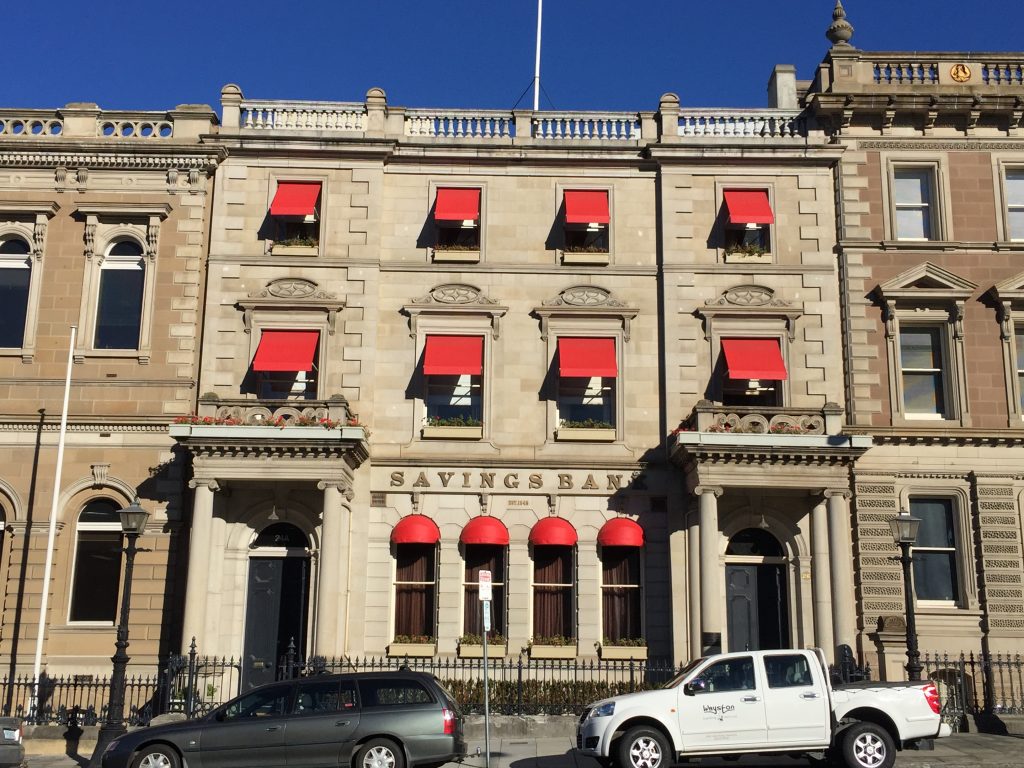Irishwoman Mary Yeoman entered the drapery store at 65 Liverpool Street early in the morning of March 1st, 1845. As a recently married convict, still under sentence, she could not have anticipated that her next action would be the start of what became a significant institution in Hobart’s history, the legacy of which is today a key feature of the city’s streetscape.
Mary (Barrett) Yeoman, originally from Cork, had been transported on the Mexborough in 1841 for the theft of two cloaks and a loaf. Her sentence was seven years.
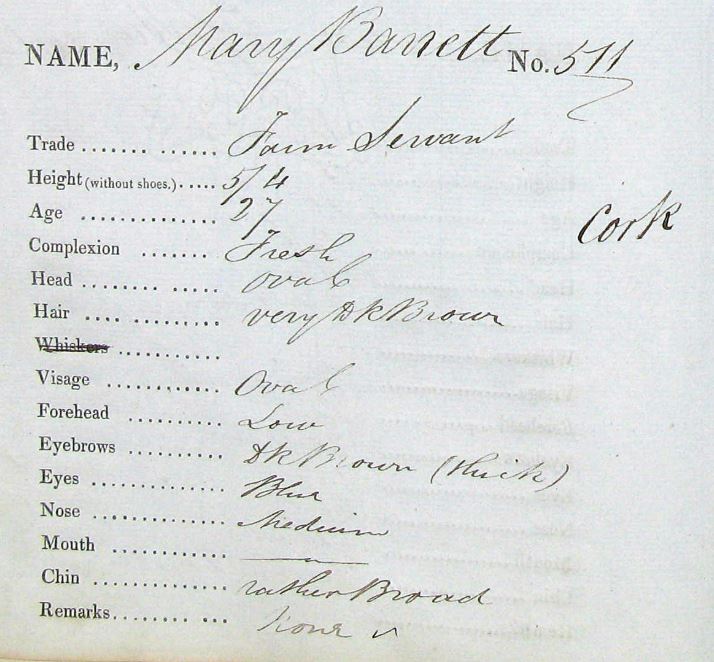

By 1844 Mary had received her ticket-of-leave after which she married former convict Michael Yeoman at St Joseph’s Catholic Church.

Six months later Mary was the first depositor at the new Hobart Savings Bank, established by Quaker shopkeeper George Washington Walker. With the assistance of his father-in-law, Robert Mather, Walker opened his own drapery shop just down the road at number 65, the corner of Murray and Liverpool Streets. (This site later became the location of AP Miller and Sons Chemist).
In Walker’s shop there was no special section set aside for bank business. All deposits were passed over the same counter where the stockings, shirts and hats and shawls were sold.
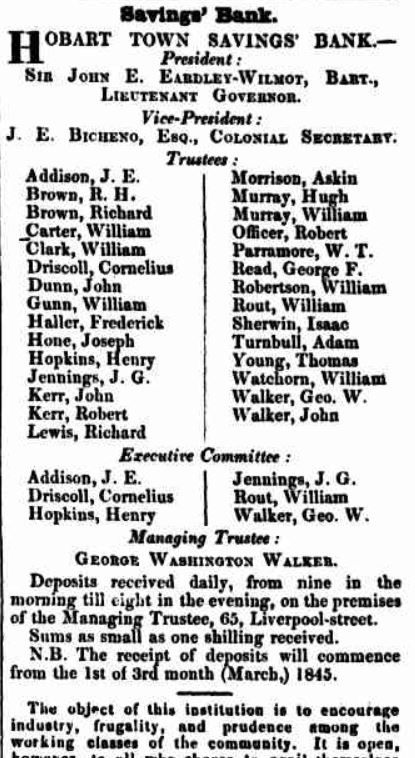
From Mary’s first small deposit the savings bank grew steadily and by its first anniversary 18,000 Hobartians had deposited over £5,000 – the equivalent of $1.15 million today.
100 years later the value of deposits sat at £6 million – $919 million today.
Philanthropist Walker started the bank as a charitable act to “encourage industry, frugality and prudence among the working classes of the community.”
In establishing the Savings Bank, Walker stated that helping people to develop the savings habit would “induce habits of self-restraint, combined with industrious effort” and “promote self-respect and independence of character.”
The Hobart Savings Bank – the first of its kind in the colony of Van Diemen’s Land – was a social experiment. While trading banks in England began in 1694 with the establishment of the Bank of England, savings banks for the common people were a new concept in the 1800s.
Trading banks dealt with businesses and worked for a profit, putting the interests of shareholders before the interests of customers. The colony’s first trading bank, the Bank of Van Diemen’s Land, opened in Hobart in 1824 and was run by merchants and men in trade, followed by the powerful and profitable Derwent Bank in 1827. Governor George Arthur was this bank’s largest shareholder. Government officers were key customers which led to accusations of the government officials using their position to influence the business decisions of the trading bank.
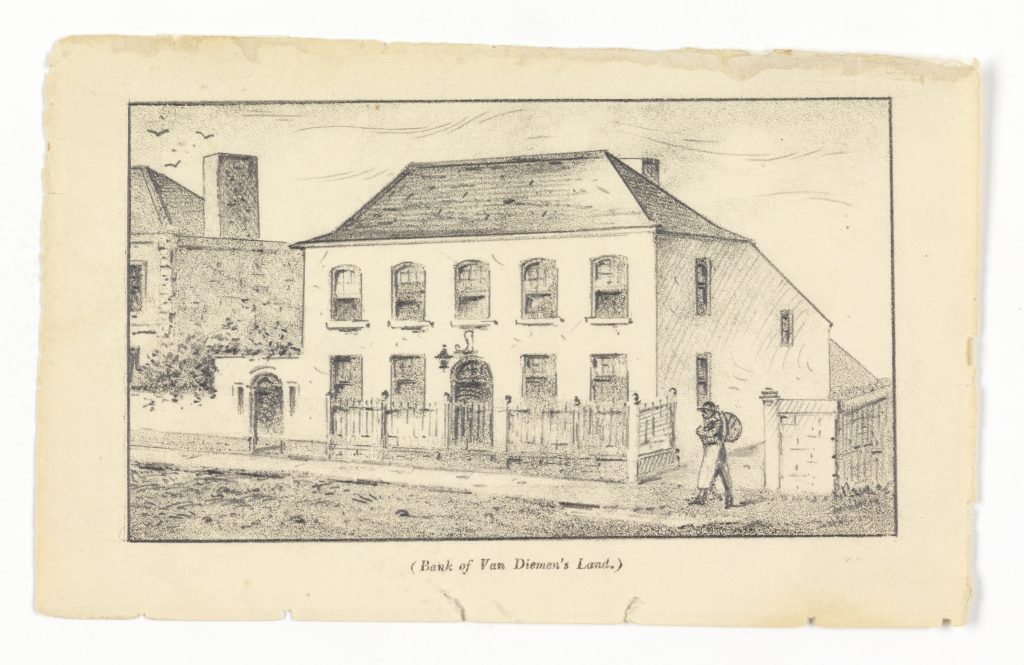
Walker opened his savings bank in 1845 as a charitable, not-for-profit institution which would deal with personal savings of the lower and labouring classes and later, home loans. He and his fellow trustees maintained that they held a moral obligation for the safe keeping of the money of their depositors.
Ten years later, in a letter to a friend, Walker declared his initial motivation was because: “I have long witnessed with sorrow the extravagance and improvidence which the poor settlers, mechanics, servants, and labourers of this Colony had fallen into. The little money that passes is quickly dissipated in spirituous liquors and gambling, a system which mainly tends to keep them poor, vicious, and unmarried, and is therefore of the deepest injury to the Colony.”
George Washington Walker arrived in Hobart from England in 1831 with James Backhouse on a Quaker missionary trip to Hobart Town. They had been sent to do what they could for the moral and religious welfare of the convicts and settlers. When they arrived, Hobart was a flourishing settlement of 8,600 people. In Hobart they conducted the first meetings of the Society of Friends in the Southern Hemisphere and inaugurated the Temperance Movement a year later. After travelling extensively around the colony, they moved on to Sydney, then South Africa. Eventually Walker returned to Hobart in 1840.
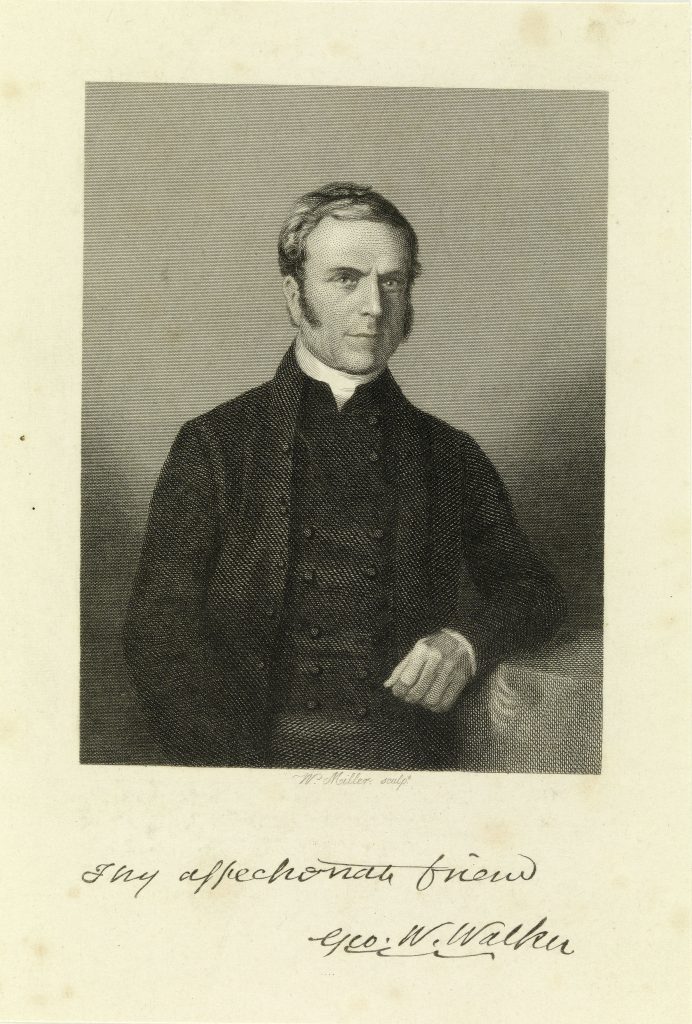
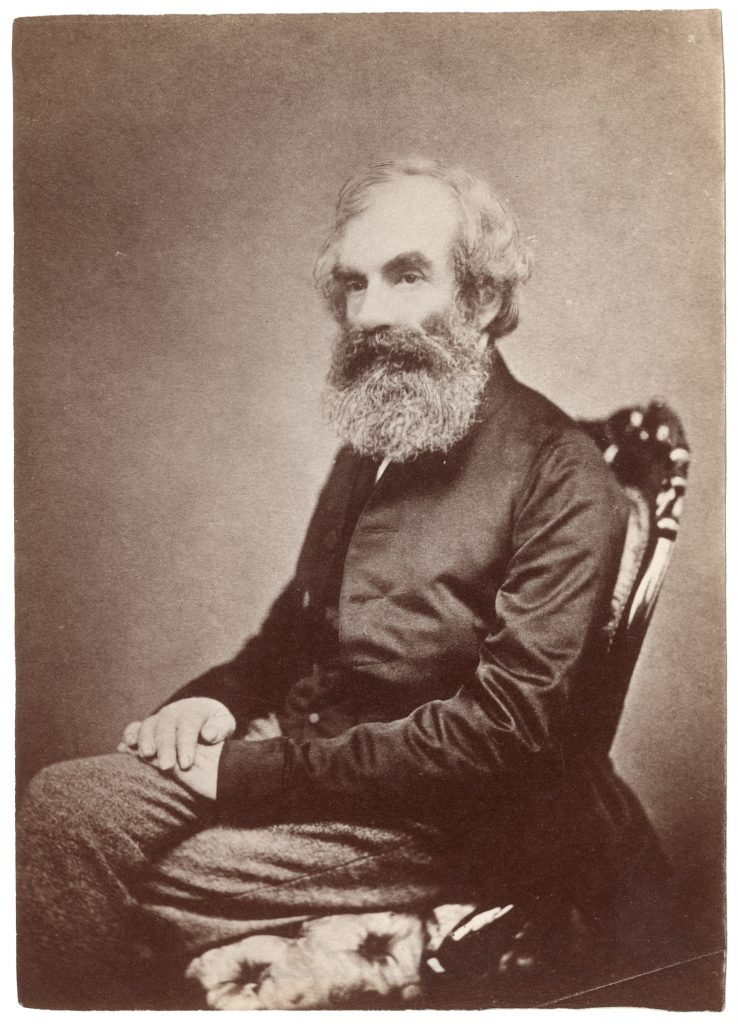
Soon after his return, Walker married Sarah Mather, to whom he had been engaged when they met in Sydney six years earlier. Sarah’s father was Robert Mather, who migrated with his family to Hobart and established a drapery shop in Liverpool Street. Mather supported Walker in establishing his own similar enterprise nearby.

Walker’s savings bank idea was supported by many leading businessmen of Hobart, as well as the patronage of Governor Sir John Eardley Wilmot. The trustees were carefully selected from among similar philanthropic men of exemplary character – most of whom were friends of Walker and Mather. The first meeting of the board was held at Gould’s pharmacy, at that time located at the corner of Elizabeth and Bathurst Streets.
Governor Eardley Wilmot was appointed the first president of the Hobart Savings Bank, first Vice-President was Colonial Secretary James Bicheno. Walker was the first Manager and convict Mary Yeoman the first depositor. Like Mary, many of the Savings Bank customers could not write or sign their names, so Walker completed their bank forms and added notes to aid in identification, with details such as height, weight, country of origin and even: “Now a teetotaller, formerly a great drunkard.”
A full range of occupations were represented among the customers – a comedian, linguist, butler, ginger beer manufacturer’s daughter, cook at the Whaler’s Return, groom, whaler and javelin man at the gaol.
Customers could deposit their small sums from 9am to 7pm, Monday to Friday and Saturday 9am-9pm. These long opening hours were to suit the needs of people who could not leave their workplace during the day to get their banking done. Depositors outside of Hobart could send their bank books via the postal service, with the cash enclosed. Deposits were limited to a maximum of £30 and customers were charged 6 pence for their bank books. Outside of Hobart, the offices of the Police Magistrates performed the role of bank branches, taking deposits for customers around the island.
The bank grew steadily and by 1853 Walker decided to leave the drapery business and focus completely on the management of the Hobart Savings Bank. New premises were leased in 1855 in the Stone Buildings, corner of Murray and Macquarie Street, opposite St David’s cathedral.
The bank’s trustees searched for a suitable Hobart CBD location to construct their own bank building. In 1856 land in Murray Street became available with the closure of the Hobart Gaol at the corner of Murray and Macquarie Streets and a year later the Hobart Savings Bank purchased a large block at 26 Murray Street. A prize of £50 was offered for the winner of the competition to design the new building. This was awarded to Edward Rowntree and construction of his design was undertaken by I and R Meikle, with Rowntree supervising the works, which started in March 1857.
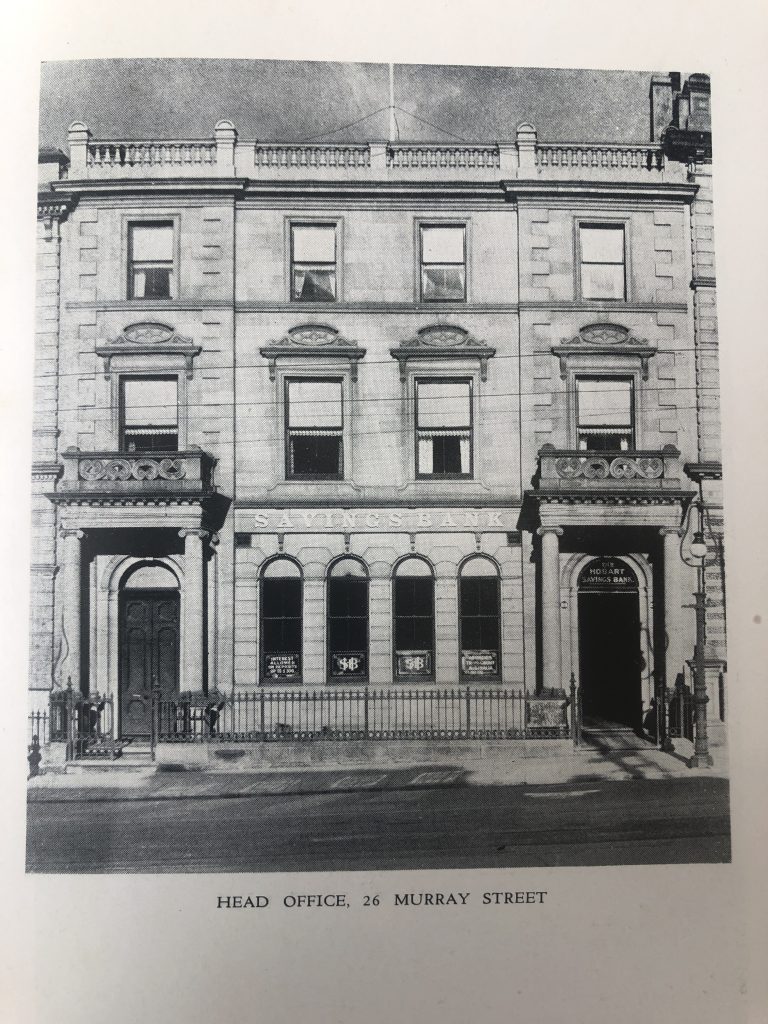
Just prior to the completion of the building in June 1859, George Washington Walker, the founder of Tasmania’s first savings bank, fell ill. He died just 5 months before the opening of the new banking premises.
Walker established the Hobart Savings Bank for the “safe custody and increase of small savings”. It was structured on a philanthropic, charitable basis and he ensured that the volunteer trustees would always act in the best interests of the depositors. This principle ensured the bank was secure from financial collapse which struck the trading banks of Tasmania during the economic depression of 1890.
At that time, banking in Tasmania was largely unregulated, with few restrictions on operations and no government-backed guarantees against loss. Many of the long-established Tasmanian trading banks collapsed in 1891 as a result of unrestrained lending for property speculation.
Throughout this time, the Hobart Savings Bank withstood the problems of the financial world and continued to develop. This was the result of the stability and sound judgment of the bank’s trustees. A significant figure in the development of the bank from the 1890s was Robert Murdoch, who as General Manager for the next 30 years, influenced the expansion of the bank more than any of his predecessors. During Murdoch’s time the bank opened many branches in the city, the suburbs and regional areas of Tasmania, the first at New Norfolk in 1913.
In 1927, with the approval of the Education Minister, Hobart Savings Bank commenced a school banking scheme and 2,400 children opened accounts. The teachers were responsible for accepting deposits and remitting the funds to the bank. By 1928 banking officers were calling at the schools each week to collect the money. School banking was enormously popular, and by 1930 there were 13,000 depositors with funds worth £16,000 (equivalent to $1.3m today)
The bank continued to promote ideals of savings and thrift. In 1935 bank president, FL Langford, attended the International Thrift Congress in Paris, along with 1,200 delegates from 30 countries.

During the Second World War, the bank consistently subscribed to the war loans floated by the Commonwealth Government, as did the majority of their depositors. Throughout the war years the bank continued to be stronger than ever, always “encouraging thrift, prudence and industry in the community.”
The Hobart Savings Bank celebrated its centenary in 1945 and over the next 46 years remained stable. During this time the bank changed its name to the Savings Bank of Tasmania. In 1991 it merged with the Tasmania Bank (formerly Launceston Bank for Savings) and together they became The Trust Bank. In 2000 this was amalgamated into the Commonwealth Bank.
